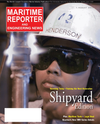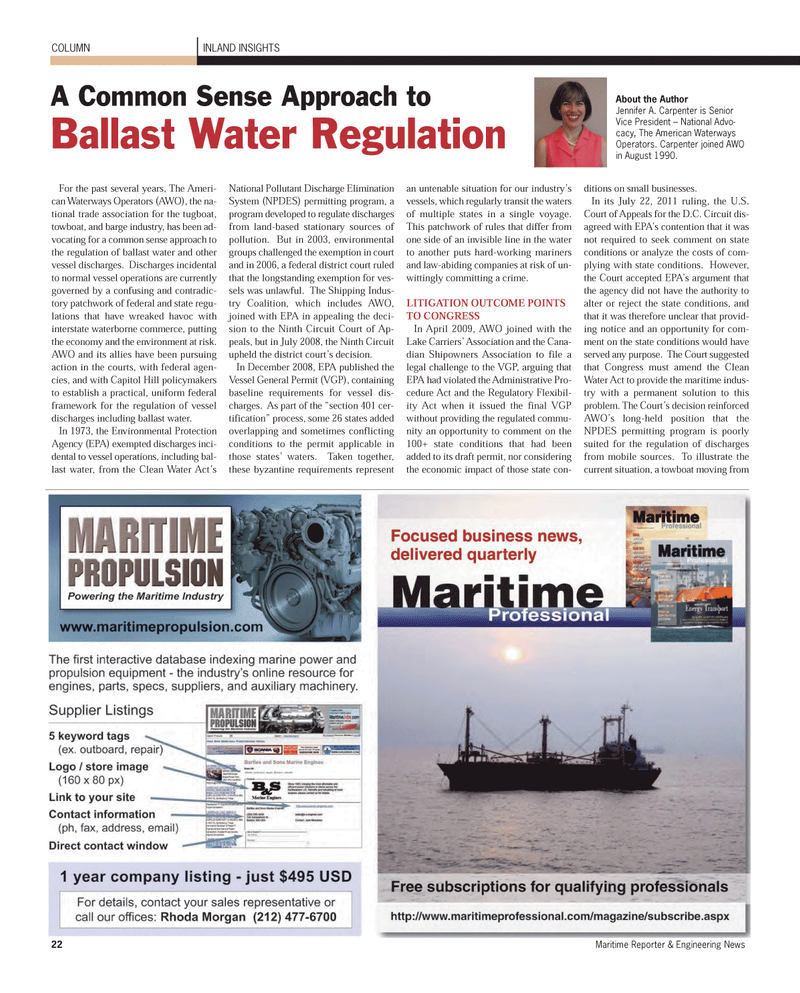
Page 22: of Maritime Reporter Magazine (August 2011)
Top 20 Shipyards of the World
Read this page in Pdf, Flash or Html5 edition of August 2011 Maritime Reporter Magazine
INLAND INSIGHTSCOLUMNA Common Sense Approach to Ballast Water Regulation For the past several years, The Ameri- can Waterways Operators (AWO), the na- tional trade association for the tugboat,towboat, and barge industry, has been ad- vocating for a common sense approach to the regulation of ballast water and other vessel discharges. Discharges incidental to normal vessel operations are currently governed by a confusing and contradic- tory patchwork of federal and state regu- lations that have wreaked havoc with interstate waterborne commerce, putting the economy and the environment at risk. AWO and its allies have been pursuing action in the courts, with federal agen-cies, and with Capitol Hill policymakers to establish a practical, uniform federalframework for the regulation of vessel discharges including ballast water. In 1973, the Environmental Protection Agency (EPA) exempted discharges inci- dental to vessel operations, including bal- last water, from the Clean Water Act?s National Pollutant Discharge Elimination System (NPDES) permitting program, aprogram developed to regulate discharges from land-based stationary sources ofpollution. But in 2003, environmental groups challenged the exemption in court and in 2006, a federal district court ruledthat the longstanding exemption for ves- sels was unlawful. The Shipping Indus- try Coalition, which includes AWO, joined with EPA in appealing the deci- sion to the Ninth Circuit Court of Ap- peals, but in July 2008, the Ninth Circuit upheld the district court?s decision. In December 2008, EPA published the Vessel General Permit (VGP), containing baseline requirements for vessel dis- charges. As part of the ?section 401 cer- tification? process, some 26 states added overlapping and sometimes conflicting conditions to the permit applicable inthose states? waters. Taken together, these byzantine requirements representan untenable situation for our industry?s vessels, which regularly transit the waters of multiple states in a single voyage. This patchwork of rules that differ from one side of an invisible line in the water to another puts hard-working mariners and law-abiding companies at risk of un- wittingly committing a crime.LITIGATION OUTCOME POINTS TO CONGRESSIn April 2009, AWO joined with the Lake Carriers? Association and the Cana- dian Shipowners Association to file a legal challenge to the VGP, arguing that EPA had violated the Administrative Pro- cedure Act and the Regulatory Flexibil- ity Act when it issued the final VGP without providing the regulated commu- nity an opportunity to comment on the100+ state conditions that had beenadded to its draft permit, nor consideringthe economic impact of those state con-ditions on small businesses. In its July 22, 2011 ruling, the U.S.Court of Appeals for the D.C. Circuit dis- agreed with EPA?s contention that it was not required to seek comment on stateconditions or analyze the costs of com-plying with state conditions. However, the Court accepted EPA?s argument that the agency did not have the authority to alter or reject the state conditions, andthat it was therefore unclear that provid- ing notice and an opportunity for com-ment on the state conditions would have served any purpose. The Court suggested that Congress must amend the CleanWater Act to provide the maritime indus- try with a permanent solution to thisproblem. The Court?s decision reinforced AWO?s long-held position that the NPDES permitting program is poorlysuited for the regulation of discharges from mobile sources. To illustrate the current situation, a towboat moving from About the AuthorJennifer A. Carpenter is SeniorVice President ? National Advo- cacy, The American Waterways Operators. Carpenter joined AWOin August 1990. 22Maritime Reporter & Engineering News MR Aug. 11 # 3 (18-24):MR Template 8/5/2011 4:06 PM Page 22

 21
21

 23
23
